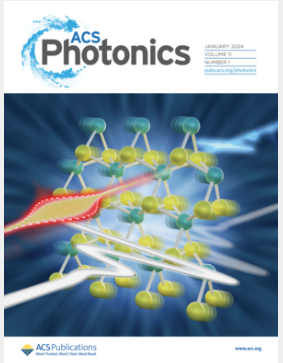Ferro-Pyro-Phototronic Effect Enhanced Self-Powered UV Photodetectors Based on BaTiO3@MXene/4H-SiC Heterojunction
IF 6.7
1区 物理与天体物理
Q1 MATERIALS SCIENCE, MULTIDISCIPLINARY
引用次数: 0
Abstract
Ferroelectric materials, known for their superior spontaneous polarization and pyroelectric and photovoltaic effects, offer a promising avenue for fabricating high-performance optoelectronic devices. Herein, we report an ultraviolet (UV) photodetector (PDs) based on BaTiO3@MXene/4H-SiC heterostructure, with its photosensitive properties significantly boosted by the ferro-pyro-phototronic effect. In the detector, the incorporation of MXene nanosheets boosts the spontaneous ferroelectric polarization of BaTiO3 nanocrystals, thereby strengthening the built-in electric field at the BaTiO3/4H-SiC heterojunction. The resulted BaTiO3@MXene/4H-SiC heterostructure can work in a self-biasing manner, with robust performances, including responsivity (∼187.74 mA/W), specific detectivity (∼6.52 × 1013 Jones), external quantum efficiency (∼75.07%), response/recovery time (∼74.3/122.7 μs) upon 310 nm light irradiation. Particularly, the superlinear increase of the photocurrent, which results from the hot-carrier multiplication in MXene nanosheets, allows the device to produce additional photocurrent under ultraviolet illumination. Theoretical analysis confirms that the surface modification of MXene nanosheets can effectively alter the length of the Ti–O bonds on BaTiO3 nanocrystal surfaces, thus enhancing their spontaneous ferroelectric polarization. Being seamlessly integrated into an ultraviolet wireless communication system, the BaTiO3@MXene/4H-SiC self-powered photodetector demonstrates promising application prospects in optoelectronic interconnection circuits. This study provides an optimization strategy for advanced BaTiO3 nanocrystals toward future high-performance electronic and optoelectronic devices in existing applications.

基于 BaTiO3@MXene/4H-SiC 异质结的铁-焦-光电效应增强型自供电紫外光检测器
铁电材料以其卓越的自发极化、热释电和光电效应而闻名,为制造高性能光电器件提供了一条前景广阔的途径。在此,我们报告了一种基于 BaTiO3@MXene/4H-SiC 异质结构的紫外线(UV)光电探测器(PDs),其光敏特性因铁-热电-光电效应而得到显著提升。在探测器中,MXene 纳米片的加入提高了 BaTiO3 纳米晶体的自发铁电极化,从而加强了 BaTiO3/4H-SiC 异质结的内置电场。所制备的 BaTiO3@MXene/4H-SiC 异质结能以自偏压方式工作,并具有强大的性能,包括响应率(∼187.74 mA/W)、比检测率(∼6.52 × 1013 Jones)、外部量子效率(∼75.07%)、在 310 纳米光照射下的响应/恢复时间(∼74.3/122.7 μs)。特别是 MXene 纳米片中热载流子倍增所产生的光电流超线性增加,使该器件在紫外线照射下产生额外的光电流。理论分析证实,对 MXene 纳米片进行表面改性可有效改变 BaTiO3 纳米晶表面 Ti-O 键的长度,从而增强其自发铁电极化。BaTiO3@MXene/4H-SiC 自供电光电探测器可无缝集成到紫外无线通信系统中,在光电互连电路中具有广阔的应用前景。这项研究为先进的 BaTiO3 纳米晶体提供了一种优化策略,使其能够在现有应用中实现未来的高性能电子和光电器件。
本文章由计算机程序翻译,如有差异,请以英文原文为准。
求助全文
约1分钟内获得全文
求助全文
来源期刊

ACS Photonics
NANOSCIENCE & NANOTECHNOLOGY-MATERIALS SCIENCE, MULTIDISCIPLINARY
CiteScore
11.90
自引率
5.70%
发文量
438
审稿时长
2.3 months
期刊介绍:
Published as soon as accepted and summarized in monthly issues, ACS Photonics will publish Research Articles, Letters, Perspectives, and Reviews, to encompass the full scope of published research in this field.
 求助内容:
求助内容: 应助结果提醒方式:
应助结果提醒方式:


